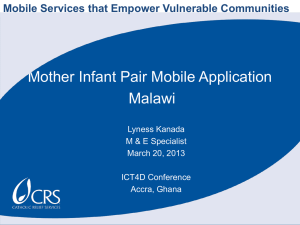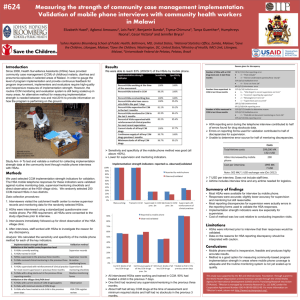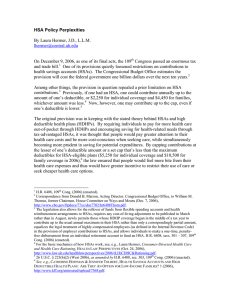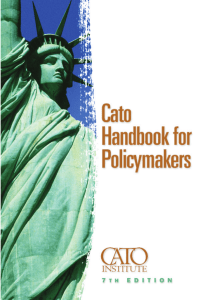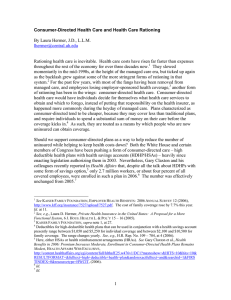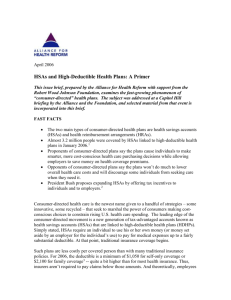Health Savings Accounts Prove Popular in the Individual Market
advertisement
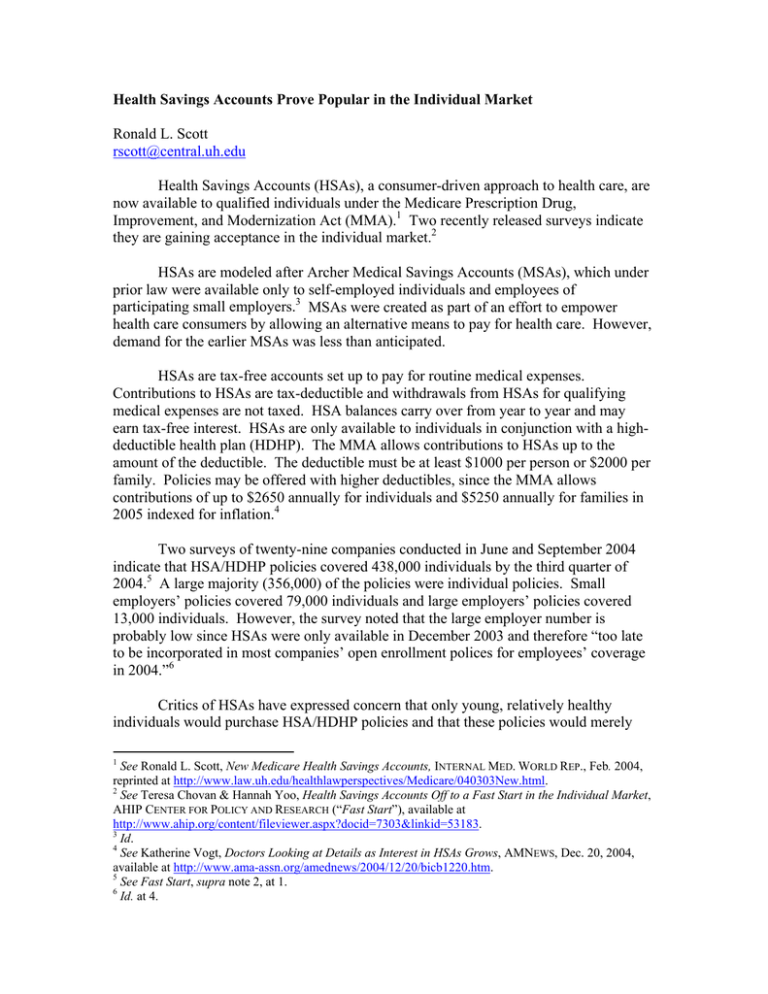
Health Savings Accounts Prove Popular in the Individual Market Ronald L. Scott rscott@central.uh.edu Health Savings Accounts (HSAs), a consumer-driven approach to health care, are now available to qualified individuals under the Medicare Prescription Drug, Improvement, and Modernization Act (MMA).1 Two recently released surveys indicate they are gaining acceptance in the individual market.2 HSAs are modeled after Archer Medical Savings Accounts (MSAs), which under prior law were available only to self-employed individuals and employees of participating small employers.3 MSAs were created as part of an effort to empower health care consumers by allowing an alternative means to pay for health care. However, demand for the earlier MSAs was less than anticipated. HSAs are tax-free accounts set up to pay for routine medical expenses. Contributions to HSAs are tax-deductible and withdrawals from HSAs for qualifying medical expenses are not taxed. HSA balances carry over from year to year and may earn tax-free interest. HSAs are only available to individuals in conjunction with a highdeductible health plan (HDHP). The MMA allows contributions to HSAs up to the amount of the deductible. The deductible must be at least $1000 per person or $2000 per family. Policies may be offered with higher deductibles, since the MMA allows contributions of up to $2650 annually for individuals and $5250 annually for families in 2005 indexed for inflation.4 Two surveys of twenty-nine companies conducted in June and September 2004 indicate that HSA/HDHP policies covered 438,000 individuals by the third quarter of 2004.5 A large majority (356,000) of the policies were individual policies. Small employers’ policies covered 79,000 individuals and large employers’ policies covered 13,000 individuals. However, the survey noted that the large employer number is probably low since HSAs were only available in December 2003 and therefore “too late to be incorporated in most companies’ open enrollment polices for employees’ coverage in 2004.”6 Critics of HSAs have expressed concern that only young, relatively healthy individuals would purchase HSA/HDHP policies and that these policies would merely 1 See Ronald L. Scott, New Medicare Health Savings Accounts, INTERNAL MED. WORLD REP., Feb. 2004, reprinted at http://www.law.uh.edu/healthlawperspectives/Medicare/040303New.html. 2 See Teresa Chovan & Hannah Yoo, Health Savings Accounts Off to a Fast Start in the Individual Market, AHIP CENTER FOR POLICY AND RESEARCH (“Fast Start”), available at http://www.ahip.org/content/fileviewer.aspx?docid=7303&linkid=53183. 3 Id. 4 See Katherine Vogt, Doctors Looking at Details as Interest in HSAs Grows, AMNEWS, Dec. 20, 2004, available at http://www.ama-assn.org/amednews/2004/12/20/bicb1220.htm. 5 See Fast Start, supra note 2, at 1. 6 Id. at 4. replace more comprehensive health insurance policies rather than encourage uninsured individuals to become insured. However, the surveys show that in the individual market, previously uninsured individuals purchased 30% of the policies.7 In addition, the age distribution of covered lives in the individual market was evenly allocated among age groups as shown below:8 Age < 20 20-29 30-39 40-49 50-59 60-64 Percentage 25% 11% 16% 24% 19% 5% HSA/HDHP polices are gaining some acceptance with small employers (up to fifty employees). The surveys reported enrollment of 79,000 individuals in small group policies as of September 2004.9 Significantly, 16% of the polices covering 22,000 employees “were sold to employers that previously offered no health care coverage to their workforce . . . .”10 The average annual deductible for individual market polices was reported at $2856 for a single policy and $5425 for a family policy.11 Annual premiums ranged from a low of $978 (single policy age 20-29) to a high of $4581 (family policy age 50-54).12 Other indicators point towards a growing acceptance of HSAs. The American Medical Association is encouraging member physicians to distribute waiting-room brochures titled Health Savings Accounts at a Glance.13 A large majority of insurers (90%) “are likely to offer HSAs by 2006 . . . .”14 BlueCross BlueShield plans to offer PPO products tied to HSAs in forty-nine states by 2006.15 It appears that HSAs will be far more successful than their predecessor Archer MSAs. Only 40,000 Archer MSAs were established the first year they were available and “they failed to achieve the same level of market penetration in 10 years that HSAs have already achieved.”16 7 Id. at 2. Id. Age distribution in the small group market was similar to the individual market. See id. 9 Id. at 3. 10 Id. 11 Id. 12 Id. 13 See Inform Your Patients about HSAs, AMNEWS, Dec. 20, 2004, available at http://www.amaassn.org/amednews/2004/12/20/edsa1220.htm. 14 Id. 15 See Robert Kazel, Blues Pledge Nationwide Expansion of HSAs, AMNews, Dec. 14, 2004, available at http://www.ama-assn.org/amednews/2004/12/13/bisb1213.htm. 16 Health Savings Accounts Off to Fast Start, New AHIP Study Shows, AMERICA’S HEALTH INSURANCE PLANS PRESS RELEASES (Jan. 12, 2005), available at http://www.ahip.org/content/pressrelease.aspx?docid=7303. 8 2
